Python Pandas Series.reindex_like()
Pandas系列是一个带有轴标签的一维ndarray。标签不需要是唯一的,但必须是一个可散列的类型。该对象支持整数和基于标签的索引,并提供了大量的方法来执行涉及索引的操作。
Pandas Series.reindex_like()函数返回一个与其他对象具有相同索引的对象。它将对象与所有轴上的相同索引相匹配。
语法: Series.reindex_like(other, method=None, copy=True, limit=None, tolerance=None)
参数:
other:它的行和列索引被用来定义这个对象的新索引。
method:用于填补重新索引的DataFrame的漏洞的方法。
copy : 返回一个新的对象,即使传递的索引是相同的。
limit :为不精确的匹配填写的最大连续标签数。
tolerance:不完全匹配的原始和新标签之间的最大距离。
返回:系列或数据框架
示例#1:使用Series.reindex_like()函数,根据其他对象对给定的系列对象进行重新索引。
# importing pandas as pd
import pandas as pd
# Creating the first Series
sr1 = pd.Series([10, 25, 3, 11, 24, 6])
# Create the Index
index_ = ['Coca Cola', 'Sprite', 'Coke', 'Fanta', 'Dew', 'ThumbsUp']
# set the index
sr1.index = index_
# Print the series
print(sr1)
# Creating the second Series
sr2 = pd.Series([10, 25, 3, 11, 24, 6, 25, 45])
# Create the Index
index_ = ['Coca Cola', 'Sprite', 'Coke', 'Fanta',
'Dew', 'ThumbsUp', 'Mirinda', 'Appy']
# set the index
sr2.index = index_
# Print the series
print(sr2)
输出 :
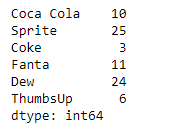
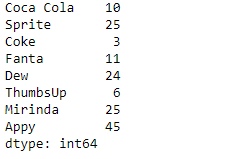
现在我们将使用Series.reindex_like()函数在sr1的基础上重新索引sr2系列对象。
# reindex sr2 using sr1
result = sr2.reindex_like(sr1)
# Print the result
print(result)
输出 :
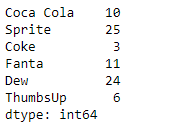
正如我们在输出中看到的,Series.reindex_like()函数已经成功地使用sr1对sr2对象进行了重新索引。注意额外的标签已经被删除。
示例#2 :使用Series.reindex_like()函数,根据其他对象重新索引给定的系列对象。
# importing pandas as pd
import pandas as pd
# Creating the first Series
sr1 = pd.Series(['New York', 'Chicago', 'Toronto', 'Lisbon', 'Rio'])
# Create the Index
index_ = ['City 1', 'City 2', 'City 3', 'City 4', 'City 5']
# set the index
sr1.index = index_
# Print the series
print(sr1)
# Creating the second Series
sr2 = pd.Series(['New York', 'Toronto', 'Lisbon', 'Rio'])
# Create the Index
index_ = ['City 1', 'City 3', 'City 4', 'City 5']
# set the index
sr2.index = index_
# Print the series
print(sr2)
输出 :
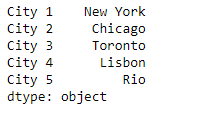

现在我们将使用Series.reindex_like()函数在sr1的基础上重新索引sr2系列对象。
# reindex sr2 using sr1
result = sr2.reindex_like(sr1)
# Print the result
print(result)
输出 :
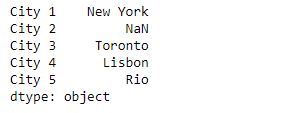
正如我们在输出中看到的,Series.reindex_like()函数已经成功地使用sr1对sr2对象进行了重新索引。请注意,在新增加的内容中使用了NaN值。
 极客教程
极客教程